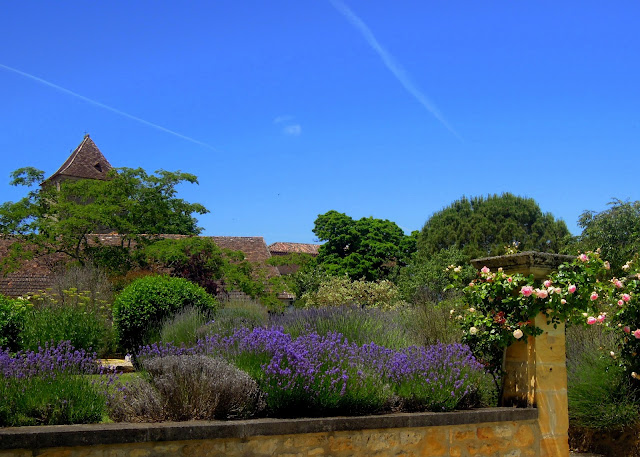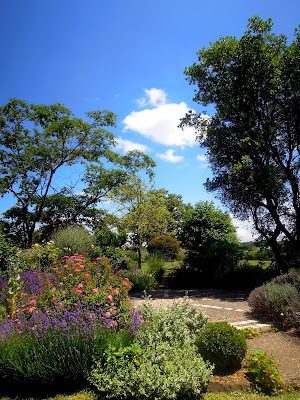There are times when I get
so caught up in the excitement and anticipation of planning out the
places that I intend to visit within the next few years that I forget to
take notice of where I actually am. And like a slap in the face, I open my eyes and realize that I'm knee-deep in lavender trimming a crawling rose
bush on an 18th century French estate.
I've landscaped before, but this was not throwing mulch on the front yard of a stuccoed suburbian McMansion. No, touch this soil, and you're transported to the times when members of the French noble class inherited these countryside mansions through the generations, living and biding time as they pleased, or using them nonchalantly as their vacation respites.
Imagine it: gazing over the rolling hills and gardens while servants tended to chores and, oh, your every whim (I'm not saying that the system was ideal...). Everything you ate was fresh (lack of refrigeration will do that) and nearly guaranteed to come from the surrounding land.There is no feeling quite like it. Who knows how long this ivy has crept up the side of the house? How long the nearby church's crumbling bell tower has announced the breaking of a new day?
And again I wonder, how did I get lucky enough to play this minor role in this estate's far-reaching history?
This is one of the things that I find most fantastic about France—the deeply-felt presence of its own past. The average Dick and Jane live in homes that have stood for hundreds of years. There's not a maniacal eagerness to tear down the old and build over with the new; people exist with time here, not against it. Cracking walnuts, making jams, raising chickens—it's the natural way in this countryside, and it simply hasn't been left behind.
The other night, a friend of Julius & Joelle's was ranting about how with growing access to supermarket food, in a few years, people "won't even know how to butcher their own rabbits!" It was as though he was complaining that people weren't using CDs now that ipods are so en vogue. And mind you, this man is a graphic designer--he works on computers all day, and yet still, like so many of the French, he understands the value of making food an interactive process, not a passive one.
I fear that many for many Americans, these sentiments have been sadly lost, but thankfully, with help from the Slow Food Movement, we are slowly regaining consciousness. Locally-grown and/or raised food, apart from helping your community and reducing your carbon footprint (among other things), just tastes better.
With that spirit in mind, here's an amazingly simple apricot jam that Joelle made while I hovered nearby. There are no exacts--Joelle is a bonafide eyeballer--but if you follow the pictures and directions, you will have made your first French jam!
 Ingredients
Ingredients
Apricots, approximately 1.5-2 lbs
Sugar
2 vanilla beans, split in half lengthwise
One immersion blender (it's not mandatory, but you really should own this magic stick)
Directions
Pit enough apricots to fill a big pan. Save the pits. Throw the vanilla beans in there. Cover the apricots with sugar. Liberally (see picture). Let sit for a few hours, or all day. Much juice will have accumulated in the pan.
Set the pan over medium-high heat. Cook cook cook until things start to get hot. Stir every once in a while. Stir more often as things get frothy. Once the froth flirts with spilling over the sides of the pan, turn the heat to medium. The apricots should be pretty tender by now (if not, wait a bit longer), so pull out that immersion blender, and have at it (depending on your desired texture, you can slice/chop the apricots beforehand instead of blending).
Keep the jam at a low simmer for a couple hours, checking every once in a while to make sure the bottom doesn't burn. When it looks like it's thickening, take a little bit out on a spoon, let it sit for a couple minutes, and see if it's an acceptable consistency. If so, take the pot off the heat, and put the jam into sterilized jars. The jam will thicken a bit more as it cools. Turn the jars upside-down to seal, and don't mess with them for at least one day. Chow.
(If you want to speed up the process or have a thicker jam, add a tsp of agar agar after blending, take off the heat, and start jarring)
So what about those pits? If you want to add a little elbow grease to this recipe, as soon as you pit the apricots, take a mallet out and hammer the pit until you have access to the lovely, almond-like kernel within. Soak the kernels in water up until you set the apricots on the burner, and slide the skins off. Throw the kernels in with the fruit before cooking. Chop finely beforehand if you're skipping the immersion blender step.
The Savings: Let's get this straight: It is always much, much cheaper to make your own preserves. There is no argument, and it's surprisingly easy. A jar of high-quality store-bought jam (meaning no added thickeners or high fructose corn syrup!) runs at about $4 for four ounces--that's $16 per pound! Clearly, if you buy apricots at around $3-5 per pound and factor in the cost of sweetener, you're still paying less than half for something fresh and homemade!
While you eat your jam, enjoy a few more pictures from our days landscaping...
thoughts? excitements? leave a comment :)
And sign up here to get the Chowgypsy travels in your inbox!
 |
| Our landscaping site in Gran Castagne |
Imagine it: gazing over the rolling hills and gardens while servants tended to chores and, oh, your every whim (I'm not saying that the system was ideal...). Everything you ate was fresh (lack of refrigeration will do that) and nearly guaranteed to come from the surrounding land.There is no feeling quite like it. Who knows how long this ivy has crept up the side of the house? How long the nearby church's crumbling bell tower has announced the breaking of a new day?
|
|
This is one of the things that I find most fantastic about France—the deeply-felt presence of its own past. The average Dick and Jane live in homes that have stood for hundreds of years. There's not a maniacal eagerness to tear down the old and build over with the new; people exist with time here, not against it. Cracking walnuts, making jams, raising chickens—it's the natural way in this countryside, and it simply hasn't been left behind.
The other night, a friend of Julius & Joelle's was ranting about how with growing access to supermarket food, in a few years, people "won't even know how to butcher their own rabbits!" It was as though he was complaining that people weren't using CDs now that ipods are so en vogue. And mind you, this man is a graphic designer--he works on computers all day, and yet still, like so many of the French, he understands the value of making food an interactive process, not a passive one.
 |
| Homemade local chicken pate for lunch |
With that spirit in mind, here's an amazingly simple apricot jam that Joelle made while I hovered nearby. There are no exacts--Joelle is a bonafide eyeballer--but if you follow the pictures and directions, you will have made your first French jam!
Easy Apricot Jam
 Ingredients
Ingredients Apricots, approximately 1.5-2 lbs
Sugar
2 vanilla beans, split in half lengthwise
One immersion blender (it's not mandatory, but you really should own this magic stick)
Directions
Pit enough apricots to fill a big pan. Save the pits. Throw the vanilla beans in there. Cover the apricots with sugar. Liberally (see picture). Let sit for a few hours, or all day. Much juice will have accumulated in the pan.
Set the pan over medium-high heat. Cook cook cook until things start to get hot. Stir every once in a while. Stir more often as things get frothy. Once the froth flirts with spilling over the sides of the pan, turn the heat to medium. The apricots should be pretty tender by now (if not, wait a bit longer), so pull out that immersion blender, and have at it (depending on your desired texture, you can slice/chop the apricots beforehand instead of blending).
Keep the jam at a low simmer for a couple hours, checking every once in a while to make sure the bottom doesn't burn. When it looks like it's thickening, take a little bit out on a spoon, let it sit for a couple minutes, and see if it's an acceptable consistency. If so, take the pot off the heat, and put the jam into sterilized jars. The jam will thicken a bit more as it cools. Turn the jars upside-down to seal, and don't mess with them for at least one day. Chow.
(If you want to speed up the process or have a thicker jam, add a tsp of agar agar after blending, take off the heat, and start jarring)
So what about those pits? If you want to add a little elbow grease to this recipe, as soon as you pit the apricots, take a mallet out and hammer the pit until you have access to the lovely, almond-like kernel within. Soak the kernels in water up until you set the apricots on the burner, and slide the skins off. Throw the kernels in with the fruit before cooking. Chop finely beforehand if you're skipping the immersion blender step.
The Savings: Let's get this straight: It is always much, much cheaper to make your own preserves. There is no argument, and it's surprisingly easy. A jar of high-quality store-bought jam (meaning no added thickeners or high fructose corn syrup!) runs at about $4 for four ounces--that's $16 per pound! Clearly, if you buy apricots at around $3-5 per pound and factor in the cost of sweetener, you're still paying less than half for something fresh and homemade!
While you eat your jam, enjoy a few more pictures from our days landscaping...
 |
| maybe I'll just, ehhh, have a dip? |
 |
| Hi, um, is that a pool I see peeking through the hedges? |
 |
| Oh look, that must be a little garden nymph |
thoughts? excitements? leave a comment :)
And sign up here to get the Chowgypsy travels in your inbox!








No comments:
Post a Comment